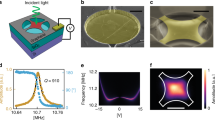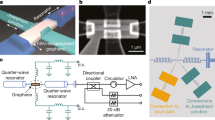Abstract
Graphene is an attractive material for use in optical detectors because it absorbs light from mid-infrared to ultraviolet wavelengths with nearly equal strength. Graphene is particularly well suited for bolometers—devices that detect temperature-induced changes in electrical conductivity caused by the absorption of light—because its small electron heat capacity and weak electron–phonon coupling lead to large light-induced changes in electron temperature. Here, we demonstrate a hot-electron bolometer made of bilayer graphene that is dual-gated to create a tunable bandgap and electron-temperature-dependent conductivity. The bolometer exhibits a noise-equivalent power (33 fW Hz–1/2 at 5 K) that is several times lower, and intrinsic speed (>1 GHz at 10 K) three to five orders of magnitude higher than commercial silicon bolometers and superconducting transition-edge sensors at similar temperatures.
This is a preview of subscription content, access via your institution
Access options
Subscribe to this journal
Receive 12 print issues and online access
$259.00 per year
only $21.58 per issue
Buy this article
- Purchase on Springer Link
- Instant access to full article PDF
Prices may be subject to local taxes which are calculated during checkout





Similar content being viewed by others
References
Castro Neto, A. H., Guinea, F., Peres, N. M. R., Novoselov, K. S. & Geim, A. K. The electronic properties of graphene. Rev. Mod. Phys. 81, 109–162 (2009).
Lee, C., Wei, X., Kysar, J. W. & Hone, J. Measurement of the elastic properties and intrinsic strength of monolayer graphene. Science 321, 385–388 (2008).
Chen, J-H., Jang, C., Xiao, S., Ishigami, M. & Fuhrer, M. S. Intrinsic and extrinsic performance limits of graphene devices on SiO2 . Nature Nanotech. 3, 206–209 (2008).
Bolotin, K. I. et al. Ultrahigh electron mobility in suspended graphene. Solid State Commun. 146, 351–355 (2008).
Du, X., Skachko, I., Barker, A. & Andrei, E. Y. Approaching ballistic transport in suspended graphene. Nature Nanotech. 3, 491–495 (2008).
Dean, C. R. et al. Boron nitride substrates for high-quality graphene electronics. Nature Nanotech. 5, 722–726 (2010).
Wallace, P. R. The band theory of graphite. Phys. Rev. 71, 622–634 (1947).
Novoselov, K. et al. Two-dimensional gas of massless Dirac fermions in graphene. Nature 438, 197–200 (2005).
Zhang, Y., Tan, Y., Stormer, H. & Kim, P. Experimental observation of the quantum Hall effect and Berry's phase in graphene. Nature 438, 201–204 (2005).
Nair, R. R. et al. Fine structure constant defines visual transparency of graphene. Science 320, 1308 (2008).
Mak, K. F., Sfeirb, M. Y., Misewich, J. A. & Heinz, T. F. The evolution of electronic structure in few-layer graphene revealed by optical spectroscopy. Proc. Natl Acad. Sci. USA 107, 14999–15004 (2010).
Gabor, N. M. et al. Hot carrier-assisted intrinsic photoresponse in graphene. Science 334, 648–652 (2011).
Kalugin, N. G. et al. Graphene-based quantum Hall effect infrared photodetector operating at liquid nitrogen temperatures. Appl. Phys. Lett. 99, 013504 (2011).
Viljas, J. K. & Heikkilä, T. T. Electron–phonon heat transfer in monolayer and bilayer graphene. Phys. Rev. B 81, 245404 (2010).
Oostinga, J. B., Heersche, H. B., Liu, X. L., Morpurgo, A. F. & Vandersypen, L. M. K. Gate-induced insulating state in bilayer graphene devices. Nature Mater. 7, 151–157 (2008).
Zhou, K. & Zhu, J. Transport in gapped bilayer graphene: the role of potential fluctuations. Phys. Rev. B 82, 081407(R) (2010).
Taychatanapat, T. & Jarillo-Herrero, P. Electronic transport in dual-gated bilayer graphene at large displacement fields. Phys. Rev. Lett. 105, 166601 (2010).
Yan, J. & Fuhrer, M. S. Charge transport in dual gated bilayer graphene with Corbino geometry. Nano Lett. 10, 4521–4525 (2010).
Zhang, Y. et al. Direct observation of a widely tunable bandgap in bilayer graphene. Nature 459, 820–823 (2009).
Mak, K. F., Lui, C. H., Shan, J. & Heinz, T. F. Observation of an electric-field-induced band gap in bilayer graphene by infrared spectroscopy. Phys. Rev. Lett. 102, 256405 (2009).
Lemme, M. C. et al. Gate-activated photoresponse in a graphene p–n junction. Nano Lett. 11, 4134–4137 (2011).
Park, J., Ahn, Y. H. & Ruiz-Vargas, C. Imaging of photocurrent generation and collection in single-layer graphene. Nano Lett. 9, 1742–1746 (2009).
Xia, F. N., Mueller, T., Lin, Y. M., Valdes-Garcia, A. & Avouris, P. Ultrafast graphene photodetector. Nature Nanotech. 4, 839–843 (2009).
Mueller, T., Xia, F. & Avouris, P. Graphene photodetectors for high-speed optical communications. Nature Photon. 4, 297–301 (2010).
Xu, X. D., Gabor, N. M., Alden, J. S., van der Zande, A. M. & McEuen, P. L. Photo-thermoelectric effect at a graphene interface junction. Nano Lett. 10, 562–566 (2010).
Skidmore, J. T., Gildemeister, J., Lee, A. T., Myers, M. J. & Richards, P. L. Superconducting bolometer for far-infrared Fourier transform spectroscopy. Appl. Phys. Lett. 82, 469–471 (2003).
Richards, P. L. & McCreight, C. R. Infrared detectors for astrophysics. Phys. Today 58, 41–47 (February 2005).
Tse, W-K., Hwang, E. H. & Das Sarma, S. Ballistic hot electron transport in graphene. Appl. Phys. Lett. 93, 023128 (2008).
Breusing, M., Ropers, C. & Elsaesser, T. Ultrafast carrier dynamics in graphite. Phys. Rev. Lett. 102, 086809 (2009).
Lui, C. H., Mak, K. F., Shan, J. & Heinz, T. F. Ultrafast photoluminescence from graphene. Phys. Rev. Lett. 105, 127404 (2010).
Wang, H. N. et al. Ultrafast relaxation dynamics of hot optical phonons in graphene. Appl. Phys. Lett. 96, 081917 (2010).
Hale, P. J., Hornett, S. M., Moger, J., Horsell, D. W. & Hendry, E. Hot phonon decay in supported and suspended exfoliated graphene. Phys. Rev. B 83, 121404(R) (2011).
Chatzakis, I., Yan, H., Song, D., Berciaud, S. & Heinz, T. F. Temperature dependence of the anharmonic decay of optical phonons in carbon nanotubes and graphite. Phys. Rev. B 83, 205411 (2011).
Stephens, R. B. Low-temperature specific heat and thermal conductivity of noncrystalline dielectric solids. Phys. Rev. B 8, 2896–2905 (1973).
Chen, Z., Jang, W., Bao, W., Lau, C. N. & Dames, C. Thermal contact resistance between graphene and silicon dioxide. Appl. Phys. Lett. 95, 161910 (2009).
Martin, J. et al. Observation of electron–hole puddles in graphene using a scanning single electron transistor. Nature Phys. 4, 144–148 (2008).
Yan, J., Henriksen, E. A., Kim, P. & Pinczuk, A. Observation of anomalous phonon softening in bilayer graphene. Phys. Rev. Lett. 101, 136804 (2008).
Efetov, D. K. & Kim, P. Controlling electron–phonon interactions in graphene at ultrahigh carrier densities. Phys. Rev. Lett. 105, 256805 (2010).
Zhang, L. M. et al. Determination of the electronic structure of bilayer graphene from infrared spectroscopy. Phys. Rev. B 78, 235408 (2008).
Song, J. C. W., Reizer, M. Y. & Levitov, L. S. Supercollisions and the bottleneck for electron-lattice cooling in graphene. Preprint at http://arXiv:1111.4678v1 (2011).
Richards, P. L. Bolometers for infrared and millimeter waves. J. Appl. Phys. 76, 1–24 (1994).
Nishioka, N. S., Richards, P. L. & Woody, D. P. Composite bolometers for submillimeter wavelengths. Appl. Opt. 17, 1562–1567 (1978).
Schwab, K., Henriksen, E. A., Worlock, J. M. & Roukes, M. L. Measurement of the quantum of thermal conductance. Nature 404, 974–977 (2000).
Wei, J. et al. Ultrasensitive hot-electron nanobolometers for terahertz astrophysics. Nature Nanotech. 3, 496–500 (2008).
Weitz, R. T., Allen, M. T., Feldman, B. E., Martin, J. & Yacoby, A. Broken-symmetry states in doubly gated suspended bilayer graphene. Science 330, 812–816 (2010).
Velasco, J. Jr et al. Transport spectroscopy of symmetry-broken insulating states in bilayer graphene. Nature Nanotech. 7, 156–160 (2012).
Heersche, H. B., Jarillo-Herrero, P., Oostinga, J. B., Vandersypen, L. M. K. & Morpurgo, A. F. Bipolar supercurrent in graphene. Nature 446, 56–59 (2007).
Engel, M. et al. Light–matter interaction in a microcavity-controlled graphene transistor. Preprint at http://arXiv:1112.1380 (2011).
Furchi, M. et al. Microcavity-integrated graphene photodetector. Nano Lett. http://dx.doi.org/10.1021/nl204512x (2012).
Acknowledgements
The authors thank J. Melngailis, D. E. Prober, H. Moseley and A. F. Heinz for discussions. This work was supported by IARPA, the ONR MURI programme and the NSF (grants DMR-0804976 and DMR-1105224) and in part by the NSF MRSEC (grant DMR-0520471). J.A.E. and H.M.M. acknowledge the support of the NSF.
Author information
Authors and Affiliations
Contributions
M.S.F. and H.D.D. conceived the project. J.Y. fabricated the devices and performed the transport measurements. M.H.K., J.Y., A.B.S. and G.S.J. conducted the photoresponse experiments. J.A.E. and H.M.M. assisted in the pump–probe measurements. J.Y., M.H.K., M.S.F. and H.D.D. analysed data and wrote the manuscript. All authors discussed and contributed to writing the manuscript.
Corresponding author
Ethics declarations
Competing interests
The authors declare no competing financial interests.
Supplementary information
Supplementary information
Supplementary information (PDF 509 kb)
Rights and permissions
About this article
Cite this article
Yan, J., Kim, MH., Elle, J. et al. Dual-gated bilayer graphene hot-electron bolometer. Nature Nanotech 7, 472–478 (2012). https://doi.org/10.1038/nnano.2012.88
Received:
Accepted:
Published:
Issue Date:
DOI: https://doi.org/10.1038/nnano.2012.88
This article is cited by
-
Large-angle twist effect
Nature Photonics (2023)
-
Ultra-broadband photoconductivity in twisted graphene heterostructures with large responsivity
Nature Photonics (2023)
-
Phase-controlled van der Waals growth of wafer-scale 2D MoTe2 layers for integrated high-sensitivity broadband infrared photodetection
Light: Science & Applications (2023)
-
Controllable synthesis by hydrothermal method and optical properties of 2D MoS2/rGO nanocomposites
Journal of Sol-Gel Science and Technology (2023)
-
Engineering symmetry breaking in 2D layered materials
Nature Reviews Physics (2021)



